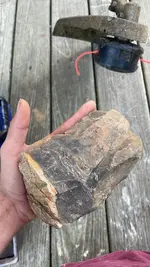dognose
Silver Member
When we traveled to our cabin in Kentucky not far from Mammoth Cave, we would drive through Sonora. It's a nice area.
I have a number of frames of Sonora chert relics. This Adena has some amazing banding and color.
The images do not do it justice,

Prehistoric Chert Types of the Midwest by Tony DeRegnaucourt and Jeff Grorgiady states: (typing in its entirety)
Origin of Chert's Name: Named for the town of Sonora in Hardin County, Kentucky near the major outcrop of the chert.
Other Names for same type: None Known
Similar Types or Look-Alikes: Some Harrison County, Indian chert and some Knox, Tennessee chert are very similar. However, these cherts lack the red iron sand and spicule inclusions. Sonora chert has occasional banding of red and orange not seen in Harrison County and Knox chert.
References: Converse (1994) and Vento (1982)
Geological Stratigraphy: St. Genevieve Member in the Slade Formation of the Upper Mississippian System.
Outcrop Location or Chert Source: Found in Hardin and Hart Counties in Central Kentucky along the Nolin River near the town of Sonora.
Naturally Occurring form of Chert: Found as "cannonball" nodules in the stream gravels of the core outcrop area.
Color: This chert is generally dark grey with occasional banding of red, cream, orange, and pink. It can be a medium to dark bluish grey also. Most examples have orange iron grains or spicules within them. Munsell colors are N3, 10B 3/1, 10B 4/1, 5YR 5/1, 5RP 6/2 and 2.5YR 3/3.
Texture: This chert ranges from waxy to vitreous in luster. It has very good knappability with the exception of chalcedonic quartz geode inclusions in a large number of specimens. Many specimens also have the iron sand grain inclusions, and these also can hamper knappability. Silicified fossils also occur as inclusions with deleterious effects to the knapper. It does not appear that this chert was heat treated since most St. Genevieve member cherts do not benefit from this process.
Minerals present: Chalcedonic quartz, cryptocrystalline quartz, hematite, pyrite, and dolomite.
Fossils: Sponge spicules, bryozoans, and brachiopod fragments.
Prehistoric Geographic Distribution: This chert mostly occurs within the central Kentucky region where it outcrops. It occasionally is found as far north as the Ohio River on the Indiana and Ohio sides. The first tier of counties of the Ohio River generally marks the northern limit of the chert although one point is known as far north as Preble County, Ohio.
Prehistoric Utilization: This chert was heavily used within its core area during all prehistoric periods. Outside of the immediate outcropping area, most examples of Sonora chert found area attributed to the Early Archaic Kirk Tradition, the Late Archaic Brewerton Phase, and the Adena Early Woodland Tradition, and the Middle Woodland Hopewell Tradition.

THIS IS THE SONORA CHERT PLATE 32 FROM THE BOOK

I have a number of frames of Sonora chert relics. This Adena has some amazing banding and color.
The images do not do it justice,
Prehistoric Chert Types of the Midwest by Tony DeRegnaucourt and Jeff Grorgiady states: (typing in its entirety)
Origin of Chert's Name: Named for the town of Sonora in Hardin County, Kentucky near the major outcrop of the chert.
Other Names for same type: None Known
Similar Types or Look-Alikes: Some Harrison County, Indian chert and some Knox, Tennessee chert are very similar. However, these cherts lack the red iron sand and spicule inclusions. Sonora chert has occasional banding of red and orange not seen in Harrison County and Knox chert.
References: Converse (1994) and Vento (1982)
Geological Stratigraphy: St. Genevieve Member in the Slade Formation of the Upper Mississippian System.
Outcrop Location or Chert Source: Found in Hardin and Hart Counties in Central Kentucky along the Nolin River near the town of Sonora.
Naturally Occurring form of Chert: Found as "cannonball" nodules in the stream gravels of the core outcrop area.
Color: This chert is generally dark grey with occasional banding of red, cream, orange, and pink. It can be a medium to dark bluish grey also. Most examples have orange iron grains or spicules within them. Munsell colors are N3, 10B 3/1, 10B 4/1, 5YR 5/1, 5RP 6/2 and 2.5YR 3/3.
Texture: This chert ranges from waxy to vitreous in luster. It has very good knappability with the exception of chalcedonic quartz geode inclusions in a large number of specimens. Many specimens also have the iron sand grain inclusions, and these also can hamper knappability. Silicified fossils also occur as inclusions with deleterious effects to the knapper. It does not appear that this chert was heat treated since most St. Genevieve member cherts do not benefit from this process.
Minerals present: Chalcedonic quartz, cryptocrystalline quartz, hematite, pyrite, and dolomite.
Fossils: Sponge spicules, bryozoans, and brachiopod fragments.
Prehistoric Geographic Distribution: This chert mostly occurs within the central Kentucky region where it outcrops. It occasionally is found as far north as the Ohio River on the Indiana and Ohio sides. The first tier of counties of the Ohio River generally marks the northern limit of the chert although one point is known as far north as Preble County, Ohio.
Prehistoric Utilization: This chert was heavily used within its core area during all prehistoric periods. Outside of the immediate outcropping area, most examples of Sonora chert found area attributed to the Early Archaic Kirk Tradition, the Late Archaic Brewerton Phase, and the Adena Early Woodland Tradition, and the Middle Woodland Hopewell Tradition.
THIS IS THE SONORA CHERT PLATE 32 FROM THE BOOK
Amazon Forum Fav 👍
Upvote
16




